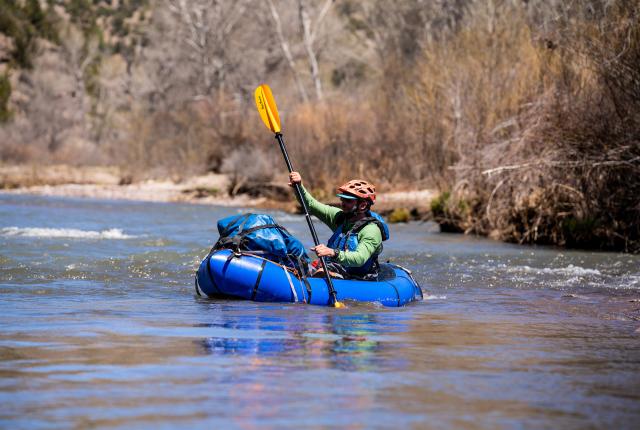OVER THE COURSE OF FIVE DAYS, we rode the edge of springtime.
An intrepid friend and I launched our packrafts— single-passenger inflatable boats—into the Gila River on a rocky riverbank with bare tree limbs around. Common black hawks whirled overhead. The water ran olive-green and cold. As we flowed down the canyon bottom, we passed massive ponderosa pines and trees fuzzed with green and scanned rock faces for pictographs and the steep walls for seeps that might lead to waterfalls.
The Wilderness Run on the Gila River stretches 38 miles, pouring out of the high peaks in the world’s first official wilderness area, the Gila Wilderness. Boats can float the river in spring as snow melts, sometimes for just a week or two. Some springs, it’s not boatable at all. The Gila offers a prize of solitude, often without even an airplane contrail overhead, and a night sky pricked with stars.
But remoteness cuts two ways. From most of our campsites, where the sun sank below the canyon rim by late afternoon and the temperature dropped from T-shirt-friendly to down-jacket-required, we often saw not so much as the flicker of a headlamp from adjacent campers. We also knew no help was within reach if we flipped a boat and faced real trouble.
The river’s small rapids rate at an intermediate Class II level, but the prevalence of “strainers,” or water flowing over downed trees and branches that can pin a boater, demands more skill, scouting, and forethought.
“There’s Class III moves, and there’s potential Class IV hazards,” says MC Neal, the Southwest region contact for the American Packrafting Association. He insists the river “goes”—if you’ve got the skills and a solo craft.
Flash floods, aggravated by recent wildfires, rearrange the river every season, scrubbing gravel bars, undercutting and toppling trees, and piling debris in new places. Last year, a particularly robust rainstorm heaped branches along the banks and pulled entire trees into the river, some blocking the whole channel. To get around those, we had to hike the boats downstream. Others permitted us to sneak around them with a few strokes.
We splashed at last into Mogollon Creek and the takeout unscathed, lines from our sandal straps tanned into the tops of our feet and the cottonwoods and willows ringing the bank thick with bright green leaves. Winter’s snow had carried us into an afternoon that felt like early summer.
Read more: Have a blast on the water by hitting these rapids.
Wilderness Run
nmmag.us/wildernessrun



